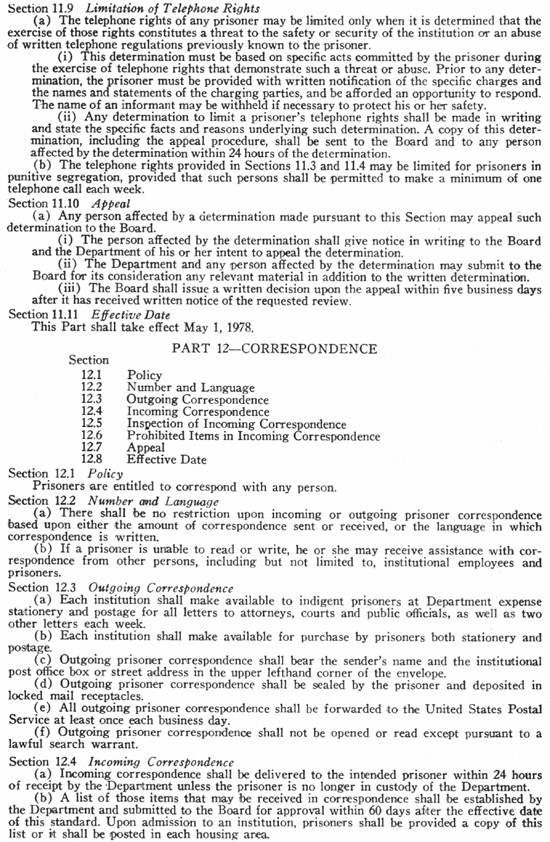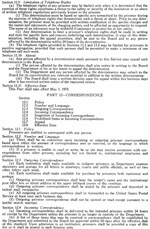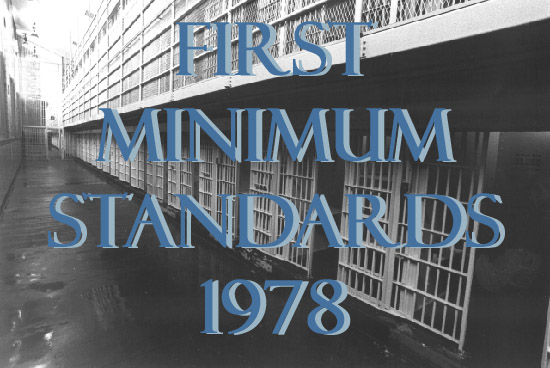|
Section
11.9 Elimitation of Telephone Rights
(a) The telephone rights of any prisoner may be limited only when it is determined that the exercise of those rights constitutes a threat to the safety or security of the institution or an abuse of written telephone regulations previously known to the prisoner.
- This determination must be based on specific acts committed by the prisoner during
the exercise of telephone rights that demonstrate such a threat or abuse. Prior to any determination, the prisoner must be provided with written notification of the specific charges and
the names and statements of the charging parties, and be afforded an opportunity to respond.
The name of an informant may be withheld if necessary to protect his or her safety.
- Any determination to limit a prisoner's telephone rights shall be made in writing
and state the specific facts and reasons underlying such determination. A copy of this determination, including the appeal procedure, shall be sent to the Board and to any person
affected by the determination within 24 hours of the determination.
(b) The telephone rights provided in Sections 11.3 and 11.4 may be limited for prisoners in punitive segregation, provided that such persons shall be permitted to make a minimum of one telephone call each week.
Section
11.10 Appeal
(a) Any person affected by a determination made pursuant to this Section may appeal such determination to the Board.
Return-to-List Icon.

If you wish to go back to the Parts List on Page 1 instead of proceeding forward, click the above icon.
|
|
- The person affected by the determination shall give notice in writing to the Board
and the Department of his or her intent to appeal the determination.
- The Department and any person affected by the determination may submit to the
Board for its consideration any relevant material in addition to the written determination.
- The Board shall issue a written decision upon the appeal within five business days
after it has received written notice of the requested review.
Section
11.11 Effective Date
This Part shall take effect May 1, 1978.
PART 12 -- CORRESPONDENCE
| Section |
| 12.1 | Policy |
| 12.2 | Number and Language |
| 12.3 | Outgoing Correspondence |
| 12.4 | Incoming Correspondence |
| 12.5 | Inspection of Incoming Correspondence |
| 12.6 | Prohibited Items in Incoming Correspondence |
| 12.7 | Appeal |
| 12.8 | Effective Date |
Page 13 of 1978 Minimum Standards.

Above is an image of Page 13 of the first publication (1978) of the Minimum Standards for New York City Correctional Facilities issued by the NYC Board of Correction, as given to NYCHS by former NYC DOC photographer Mark Mellett. NYCHS appreciates this and other archival material Mark Mellett has generously donated.
Click on the above image to bring up a larger JPG version (at the bottom of which is a link to click to return here).
 Left is another image of Page 13 of the first publication (1978) of the Minimum Standards. Click on it to access an Adobe Acrobat (PDF) downloadable and printable scanned copy (743 K) of the original Page 13.
Use your browser's "back" button to return to this page in order to navigate through the rest of this presentation.
|
|
Section
12.1 Policy
Prisoners are entitled to correspond with any person.
Section
12.2 Number and Language
(a) There shall be no restriction upon incoming or outgoing prisoner correspondence based upon either the amount of correspondence sent or received, or the language in which correspondence is written.
(b) If a prisoner is unable to read or write, he or she may receive assistance with correspondence from other persons, including but not limited to, institutional employees and prisoners.
Section
12.3 Outgoing Correspondence
(a) Each institution shall make available to indigent prisoners at Department expense stationery and postage for all letters to attorneys, courts and public officials, as well as two other letters each week.
(b) Each institution shall make available for purchase by prisoners both stationery and postage.
(c) Outgoing prisoner correspondence shall bear the sender's name and the institutional post office box or street address in the upper lefthand corner of the envelope.
(d) Outgoing prisoner correspondence shall be sealed by the prisoner and deposited in locked mail receptacles.
(e) All outgoing prisoner correspondence shall be forwarded to the United States Postal Service st least once each business day.
(f) Outgoing prisoner correspondence shall not be opened or read except pursuant to a lawful search warrant.
Section
1.4 Incoming Correspondence
(a) Incoming correspondence shall be delivered to the intended prisoner within 24 hours of receipt by the Department unless the prisoner is no longer in custody of the Department.
(b) A list of those items that may be received in correspondence shall be established by the Department and submitted to the Board for approval within 60 days after the effective date of this standard. Upon admission to an institution, prisoners shall be provided a copy of this list or it shall be posted in each housing area.
| 

